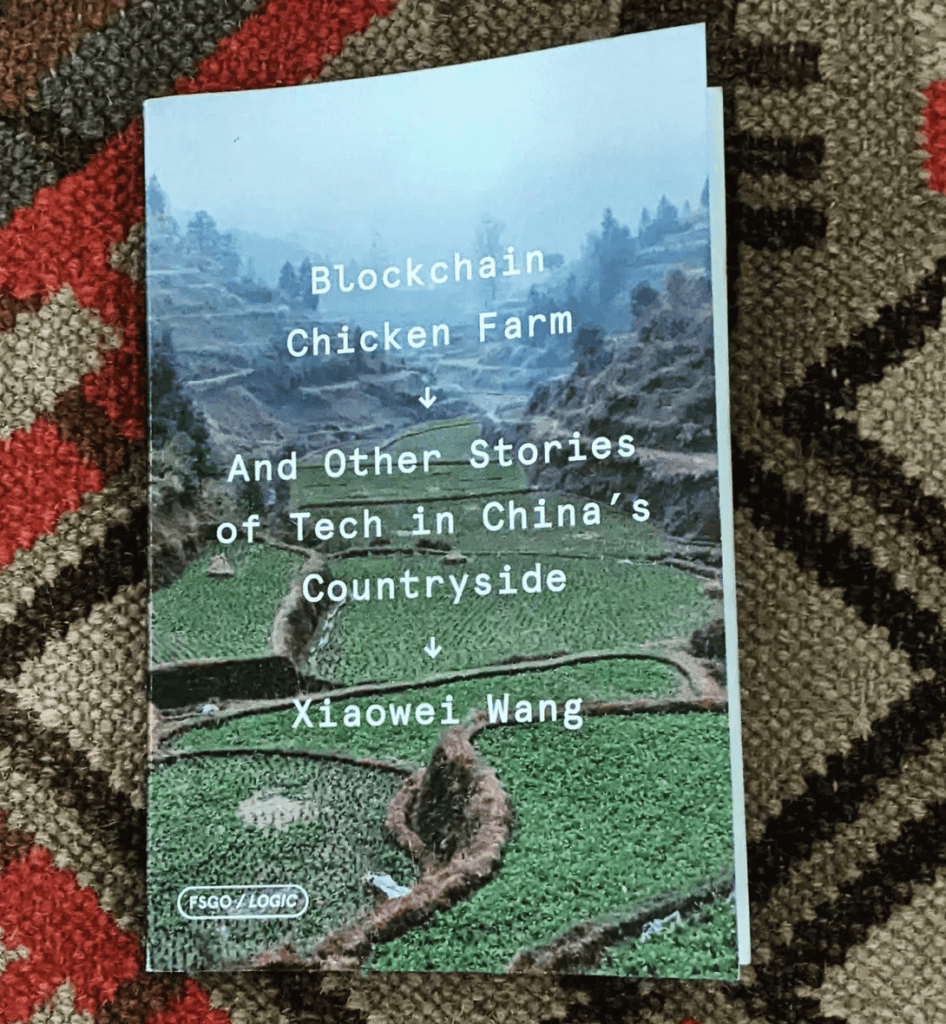Xiaowei Wang
I bought the book because it had two keywords that interested me – blockchain and China. But as the ‘stories’ went from swine to finally pearls, I realised that the title probably doesn’t do justice to the multiple themes that surface in the book and makes it, a rich and nuanced read.
The introduction points us to ‘metronormativity’ – the idea that rural people and culture are ‘backward, conservative and intolerant, and that the only way to live with freedom is to leave the countryside for highly connected urban oases.’ Further, that internet, technology and media will educate and save them by allowing more experiences and chances of a better livelihood. The book is a challenge to all parts of this construct. It also pushes back on binary classifications we employ – digital/physical, natural/man-made and so on.
‘Ghosts in the Machine’ sets the context as we read about how under Deng Xiaoping in the 1980’s, the country began imagining a uniquely Chinese future, and set the ball rolling for the rise of companies like Huawei and Alibaba. In parallel, there’s the rise of TVEs (Town and Village Enterprises) over the prevalent SOEs (State Owned Enterprises), and a potential ‘agrarian transition’ that would result in industrialised agriculture, which would need lesser manpower. This would have social, environmental and political ramifications.
‘Blockchain farm in the middle of nowhere’ touches upon the surveillance state, non-explicit censorship, and ‘the shadowy unease that looms over public conversations.’. It begins with the foodsheds in Shanghai and moves to the contrast (or not) between the dangers of cost-cutting in the food industry, and the gloss of ‘blockchain chicken’ (Bubuji/GoGoChicken). The latter uses ‘a chicken Fitbit of sorts’ on the ankle of chicken which allows a buyer to know the provenance of a chicken, and even see streaming live footage that can be accesses via a QR code! But despite this, the future is uncertain because the tech is on hire, and overhead costs are high. Can blockchain make food safety records tamper-proof by creating a distributed system? Perhaps, but there are many challenges including legibility and thus, access.
In ‘When AI farms pigs’, we are introduced to Alibaba’s ET Agricultural Brain that aims to transform agriculture to ‘help create China’s pork miracle’. It brings out how, despite AI’s potential to radically help humans, the current economics of AI makes it a corporate AI model that is all about scale and efficiency.
‘Buffet Life’ explores the alternate careers that Chinese youth are taking up. Case in point – drone operators. This is backed by a (state backed) system that is now bridging the gap between urban and rural education, creating the infrastructure for it and thereby also providing new means of livelihood.
In ‘Made in China’, there is a very insightful take on what ‘innovation’ means and how it is predominantly evaluated through a Western lens. China is forging its own path in ‘innovation’, trying to break away from cheap products at industrialised scale. ‘Shanzai’ is changing its earlier connotation to an ecosystem that’s open source, and operating at hyper speed, steamrolling through the IP version favoured by the West, and forcing conversations on access and civility. The agricultural version of this approach is Rice Harmony, and its method of collective, organic rice farming. There is also the fascinating tale of Naomi Wu, a self-proclaimed cyborg, and an internet star.
‘No one can predict the future’ is as much about policing as it is about community and identity, and the difference between ‘safety’ and ‘security’. It is interesting how many people working in the domain view surveillance as a technical problem to be solved without thinking of the related consequences. There is also a mention of ‘criminal villages’, the Chinese version of India’s Jamtara.
‘Gone shopping in the mountain stronghold’ relates how ‘Rural Revitalisation’ relies on technology and the internet to build rural entrepreneurship ecosystems. The rural playbook of Taobao is a phenomenon, one that is transforming the rural landscape, literally and metaphorically. Others like JD.com and Pinduoduo are replicating this too. And thanks to this, there is a reverse migration to the village. But many of these platforms are unregulated, resulting in safety issues – everything from getting sick from food purchases to a cab driver raping and killing a passenger.
‘Welcome to my pearl party’ is the one I found most poignant. While the story is about pearl farming in China leading to an MLM sales machinery in the US, the underlying socio-cultural dimension of it – the human need for belonging and care – is what makes it an affecting read. This also features a ‘subversive’ version of Peppa Pig, or rather it becoming a mascot for those who are rebelling against the part of society which has everything and sets the rules – shehui ren culture.
While these are all set in different parts of China, there are themes that I could see were universal – ‘…the plague of being old and lonely. As younger generations leave villages, hometowns and even the country to chase after careers and jobs, and the tightening noose of inequality squeezes leisure time, the elderly are left to their own devices.”
Blockchain, and fantastic perspectives of China were indeed part of the mix, but Xiaowei Wang delivered far more. Travelogue, technology, culture and community, future and sometimes even a bit of contemplative philosophy, I really wouldn’t want to slot this book in any particular genre, and that’s probably what makes it a compelling and fulfilling read.
P.S. In the penultimate page, the author, sitting in a HongKong bar, amidst the protests, writes about reports of a zootonic disease from mainland China causing flu-like symptoms in humans causing unease because the memory of SARS still being recent!


Leave a Reply